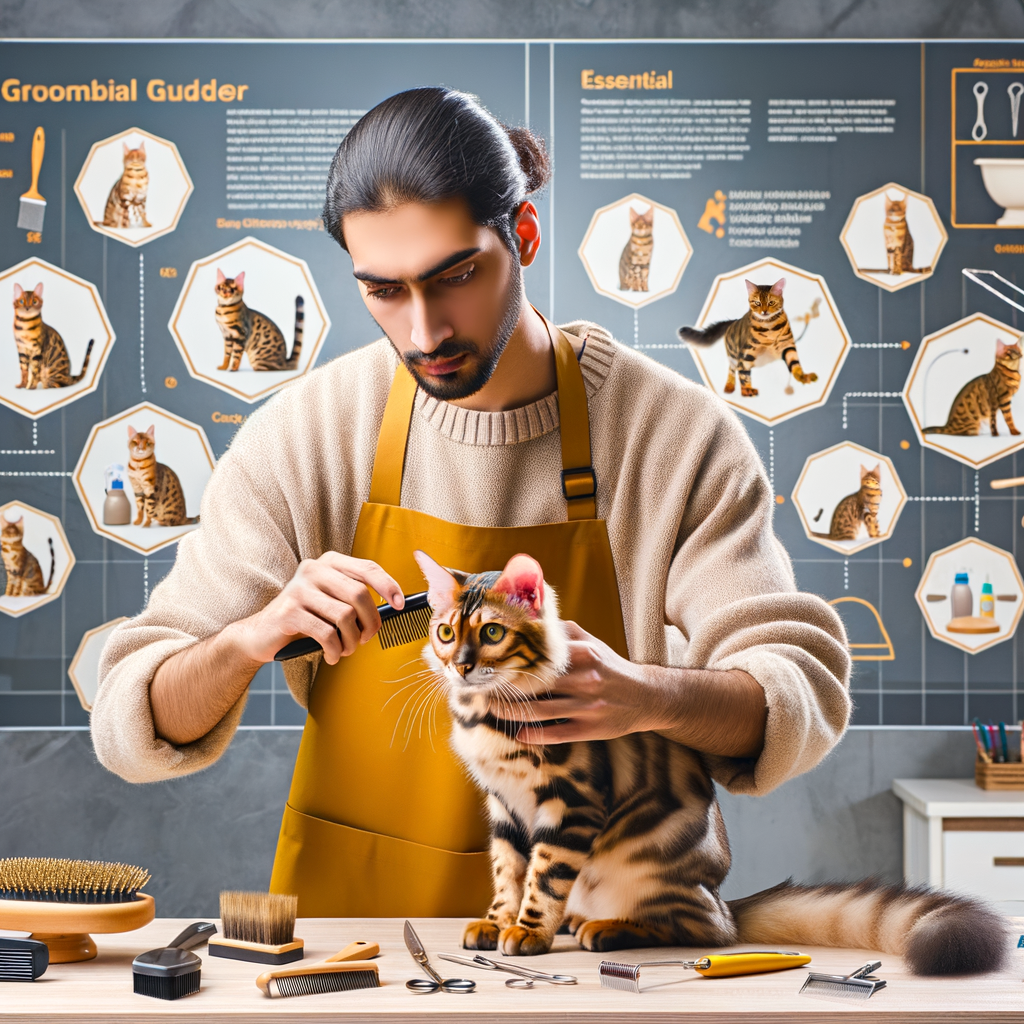
Bengal Cat Care: An Overview
When it comes to Bengal cat care, there are several key aspects to consider. One of the most important is grooming. Regular grooming is not just about keeping your Bengal cat looking its best, it also has significant health benefits. In this article, we will delve into the importance of regular grooming, understanding the unique coat of a Bengal cat, and the health benefits of grooming.
Regular grooming is crucial for all cats, but it’s particularly important for Bengal cats. Bengal cats have a dense and luxurious coat that can easily become tangled or matted if not properly cared for. Regular grooming helps to prevent these issues, keeping your cat’s coat looking shiny and healthy. It also provides an opportunity to check for any signs of skin issues or parasites.
Bengal cats have a unique coat that sets them apart from other breeds. Their fur is short, dense, and incredibly soft to the touch. It’s also known for its distinctive ‘glitter’ effect, which gives the coat a shiny, metallic sheen. This unique coat requires special care to keep it looking its best. Regular grooming with a brush designed for short-haired cats is recommended.
Regular grooming does more than just keep your Bengal cat looking good – it also has significant health benefits. Grooming helps to remove loose hair, reducing the risk of hairballs. It also stimulates blood circulation, which can help to keep your cat’s skin healthy. Additionally, grooming provides an opportunity to check for any signs of health issues, such as lumps, bumps, or skin abnormalities.
In conclusion, regular grooming is an essential part of Bengal cat care. Not only does it keep your cat’s unique coat looking its best, but it also provides numerous health benefits. So, make sure to incorporate regular grooming into your Bengal cat’s care routine.
Bengal Cat Grooming Tips
Grooming your Bengal cat is not just about maintaining their stunning appearance, it’s also about keeping them healthy and happy. Let’s explore the basic grooming tools you’ll need.
Basic Cat Grooming Tools
Before we delve into the specifics of grooming a Bengal cat, it’s essential to understand the basic tools you’ll need. These tools are crucial for maintaining your cat’s coat, nails, and overall hygiene.
-
- Choosing the Right Brush
Brushing your Bengal cat regularly is essential for removing loose hair and preventing hairballs. Bengal cats have short, dense coats, so a soft-bristle brush or a rubber grooming mitt is ideal. These tools are gentle on your cat’s skin and effective in removing loose hair.
-
- Importance of Nail Clippers
Nail clippers are another essential grooming tool. Bengal cats are active and love to climb, so their nails can become sharp and long. Regular trimming with a cat-specific nail clipper can prevent injuries and damage to your furniture. Remember, never use human nail clippers as they can split your cat’s nails.
-
- Using Grooming Wipes
Finally, grooming wipes are a convenient tool for quick clean-ups. They’re perfect for wiping down your Bengal cat’s coat, cleaning their paws, or freshening them up between baths. Choose unscented wipes to avoid irritating your cat’s sensitive nose.
Remember, grooming is also a bonding activity. It’s a time for you to connect with your Bengal cat, so make sure it’s a positive experience for both of you. Always be gentle and patient, and reward your cat with treats and praise.
Bengal Cat Hair Care
One of the most striking features of a Bengal cat is its beautiful, glossy coat. However, maintaining this coat requires proper care. In this section, we will discuss the unique characteristics of the Bengal cat’s coat, how to manage shedding, and ways to prevent hairballs.
-
- Understanding the Bengal Cat’s Coat
The Bengal cat’s coat is unlike any other cat breed. It is short, dense, and incredibly soft to the touch. The coat comes in a variety of colors and patterns, but all Bengal cats have a distinct ‘glitter’ effect, which makes their coat shimmer in the light. This unique feature is due to the transparent hair shafts that reflect light.
-
- How to Deal with Shedding
Despite their short coats, Bengal cats do shed, especially during the change of seasons. Regular brushing can help manage this shedding. Using a brush with soft bristles can gently remove loose hairs and distribute natural oils throughout the coat, keeping it healthy and shiny. It’s recommended to brush your Bengal cat at least once a week.
-
- Preventing Hairballs
As with all cats, Bengals can develop hairballs from grooming themselves. Regular brushing can help reduce the amount of hair your cat ingests. In addition, a diet high in fiber can help prevent hairballs by aiding digestion and helping to move hair through the digestive tract. Always consult with your vet to determine the best diet for your Bengal cat.
In conclusion, Bengal cat hair care involves understanding their unique coat, managing shedding, and preventing hairballs. With these tips, you can ensure your Bengal cat’s coat remains as stunning as it is healthy.
Grooming Techniques for Bengal Cats
Keeping your Bengal cat looking its best involves regular grooming. This section will guide you through the best brushing techniques for Bengal cats.
Bengal Cat Brushing Techniques
Brushing your Bengal cat is not just about keeping their coat looking shiny, it’s also about keeping their skin healthy. Here are some techniques to consider:
-
- How Often to Brush
Brushing your Bengal cat should be done at least once a week. This frequency helps to remove loose hairs and prevent matting. However, during shedding seasons, you may need to brush your cat more often to keep their coat in top condition.
-
- Brushing Techniques
When brushing your Bengal cat, always brush in the direction of hair growth. This helps to distribute natural oils throughout the coat, promoting a healthy shine. Start from the head and work your way down to the tail, being gentle to avoid hurting your cat. Using a brush designed for short-haired cats will yield the best results.
-
- Dealing with Matted Fur
Matted fur can be a problem for Bengal cats, especially if they are not brushed regularly. If you notice any mats, do not try to pull them apart with your hands. Instead, use a comb to gently tease the mat apart. If the mat is too tight, you may need to seek professional help to avoid hurting your cat.
Remember, grooming is also a bonding time between you and your cat. So, make it a pleasant experience for both of you. With these techniques, your Bengal cat will not only look good but also feel good.
Bengal Cat Fur Maintenance
One of the most striking features of a Bengal cat is its beautiful, glossy coat. Maintaining this coat requires some special care. Here are some key aspects to consider:
-
- Keeping the Coat Shiny
Bengal cats have a unique coat that shines in the light, often referred to as ‘glitter’. To keep this coat shiny, regular brushing is essential. Brushing removes loose hairs and stimulates the skin, promoting the production of natural oils that give the coat its shine. A diet rich in high-quality proteins and fats can also contribute to a healthy, glossy coat.
-
- Dealing with Common Skin Issues
Bengal cats, like all breeds, can experience skin issues. Common problems include allergies, which can cause itching and discomfort, and parasites like fleas and mites. Regular grooming can help you spot these issues early. If your Bengal cat is excessively scratching or seems uncomfortable, it’s important to consult a vet. They can recommend treatments and suggest changes to your grooming routine to help manage these issues.
-
- Importance of Regular Vet Check-ups
Regular vet check-ups are crucial for maintaining your Bengal cat’s overall health, including its coat. Vets can spot potential health issues early, before they become serious. They can also provide advice on diet and grooming to help keep your Bengal’s coat in top condition. Aim for a check-up at least once a year, or more frequently if your cat has ongoing health issues.
In conclusion, maintaining a Bengal cat’s coat involves regular grooming, a healthy diet, and regular vet check-ups. With the right care, your Bengal’s coat can remain shiny and healthy, reflecting the vibrant health of your feline friend.
How to Groom a Bengal Cat: Step-by-Step Guide
Proper grooming is essential for the health and happiness of your Bengal cat. Here is a simple, step-by-step guide to help you through the process.
-
- Preparing Your Cat
Before you start grooming, it’s important to make sure your cat is comfortable. Spend some time petting and soothing your cat to help them relax. You can also use treats as a reward for good behavior during grooming.
-
- Brushing the Coat
Bengal cats have a short, dense coat that requires regular brushing. Use a soft-bristle brush or a grooming glove to gently remove loose hair and prevent matting. Brushing your Bengal cat’s coat once a week should be sufficient.
-
- Cleaning the Ears
Regular ear cleaning is essential to prevent infections. Use a soft, damp cloth to gently clean the outer part of your cat’s ears. Never insert anything into your cat’s ear canal. If you notice any redness, swelling, or discharge, consult your vet immediately.
-
- Trimming the Nails
Trimming your Bengal cat’s nails can help prevent scratching injuries. Use a cat nail trimmer and be careful not to cut into the quick, the sensitive part of the nail. If you’re unsure about how to do this, ask your vet for a demonstration.
-
- Bathing Your Bengal Cat
Bengal cats are known for their love of water, which can make bath time easier. Use a cat-friendly shampoo and warm water. Rinse thoroughly to remove all soap. Remember to dry your cat completely to prevent them from getting cold.
Remember, grooming is not just about keeping your cat looking good, it’s also an opportunity to check for any signs of health issues. Regular grooming can help you spot potential problems early, when they’re easier to treat.
Bengal Cat Grooming Guide: Additional Tips
While the above steps provide a basic grooming routine, there are additional tips that can help keep your Bengal cat healthy and happy. These include regular dental care, feeding a balanced diet, and providing plenty of exercise and mental stimulation.
Bengal Cat Coat Care: Final Thoughts
Caring for your Bengal cat’s coat is an important part of their overall health and well-being. Regular grooming not only keeps your cat looking their best, but it also helps to strengthen the bond between you and your pet. Remember, a well-groomed cat is a happy cat!
Bengal Cat Grooming Guide: Additional Tips
As a Bengal cat owner, you want to ensure your feline friend is always looking and feeling its best. Here are some additional tips to help you in your grooming journey.
-
- When to Seek Professional Help
While grooming your Bengal cat at home is usually sufficient, there may be times when professional help is needed. If your cat has a severe matting problem, a skin condition, or if they’re extremely resistant to grooming, it might be time to call a professional groomer. They have the tools and expertise to handle these situations safely and effectively.
-
- Understanding Your Cat’s Behavior During Grooming
It’s important to understand your Bengal cat’s behavior during grooming. If they seem uncomfortable or stressed, it’s best to stop and try again later. Remember, grooming should be a positive experience for your cat, not a stressful one. Pay attention to their body language and adjust your approach as needed.
-
- How to Make Grooming a Positive Experience
There are several ways to make grooming a positive experience for your Bengal cat. First, start grooming them at a young age so they get used to it. Second, always be gentle and patient during grooming sessions. Finally, reward your cat with treats and praise after grooming to reinforce the positive association.
Remember, every Bengal cat is unique and may have different grooming needs. Always consult with your vet or a professional groomer if you have any questions or concerns about grooming your Bengal cat.
Bengal Cat Coat Care: Final Thoughts
As we wrap up our comprehensive guide on Bengal cat grooming, let’s revisit some of the key points we’ve discussed. These final thoughts will help you maintain your Bengal cat’s coat in the best possible condition.
-
- Importance of Consistency
Consistency is the cornerstone of effective grooming. Regular grooming sessions not only keep your Bengal cat’s coat looking its best, but also help to build a strong bond between you and your pet. Aim to groom your Bengal cat at least once a week. This will help to prevent matting and tangles, and will also give you a chance to check for any skin issues or parasites.
-
- Benefits of a Well-Groomed Bengal Cat
A well-groomed Bengal cat is not just a sight to behold, but also a healthier and happier pet. Regular grooming helps to distribute natural oils throughout the coat, promoting a healthy shine. It also stimulates blood circulation, contributing to overall health. Moreover, grooming sessions provide an opportunity to spot any health issues early, such as skin problems or parasites.
-
- Recap of Key Grooming Techniques
Throughout our guide, we’ve covered a range of grooming techniques. Remember, it’s important to use a brush suitable for your Bengal cat’s short, dense coat. Start by brushing in the direction of hair growth to remove loose hairs and detangle. Then, brush against the direction of hair growth to remove any remaining loose hairs and stimulate the skin. Don’t forget to regularly check and clean your cat’s ears, teeth, and nails as part of your grooming routine.
In conclusion, grooming is an essential part of Bengal cat care. By maintaining a consistent grooming routine and using the right techniques, you can ensure your Bengal cat’s coat remains healthy, shiny, and beautiful.














